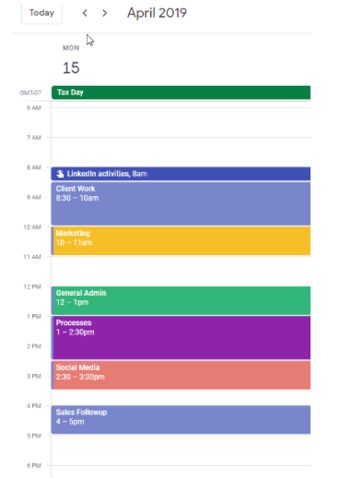The most successful CEOs put time on their calendars to get more stuff done.

Why? Designating time to these certain tasks forces the CEO to complete them while preventing all their time from “wicking away” into the daily minutiae of operational and administrative assignments.
If you’re a business owner you understand how easy it can be to become stuck “IN” your business. The many things that will advance your business fall to the wayside as you get distracted by the daily grind because that’s what you are more comfortable doing and because it’s part of your routine. Things like running to the store to get ink for the office printer when the time could be spent working on billable hours, or completing your own book work for yourself rather than giving it to your staff when you should be attending that networking event to increase your business visibility.
As a business owner, it's important to understand the value of your time. Activities that can be delegated will make better sense when you understand your time is more valuable. If you have the ability to make $100/hour with your time, then you doing admin makes that activity very costly!

Secondly, successful CEOs schedule their “stuff” (which we will call work items here), because it means they don’t have to rely on a big list of things to do, which is often overwhelming. They intuitively know that lists in general are bad, because they get big and unmanageable. Big because new work-items are always being added and older work-items get pushed down. Unmanageable because only the work items at the top get worked on because those are seen as more important, and chronologically important tasks always end up at the top; you know the new work items that came in today thus seem urgent and pushes the existing work-items that were supposed to be done today further down the list. Many business owners get stuck in this cycle - they either have a list like this or they have no list at all and are just running from one thing to the next. Those who have a big and unmanageable list are at least trying to prioritize the work as it comes in, but they have no plan for prioritizing so they just put everything on the list and start from the top.
Obviously, successful CEOs have to prioritize their work, but how do they get more than the top few things checked off their list? Well, they categorize their work and then prioritize within categories.
At INFIX, we call this the “Silo Priorities” method. A Silo in these terms is the verb meaning to isolate (one system, process, department, etc.) from others, i.e. to be siloed. In our method we use silos to isolate the activities that a business owner normally does into groups or categories of like stuff.

For instance, there can be a silo for work-items specific to tasks for clients, call this silo Client-Work, and another silo for work-items specific to internal business administrative tasks, call this silo General-Admin. There can be many other silos, like Business-Development, Accounting, Networking, etc. It doesn’t matter how many silos there are, but they should be fairly high level so you don’t end up with too many, for example don’t have a silos for each customer just have the Customer-Tasks silo. We found about 10-12 silos is optimal.
Next, once all the work-items have been categorized into silos, the method sorts all the work-items within a silo by an assigned priority. Our method uses High, Medium, and Low priorities because this way we can do a classic triage activity to identify the priority of each work item. Think of high as the must-dos, the medium as the should-dos, and the low as the could-dos. Every time a new work item comes in it is first categorized to find the right silo in which it belongs, and then triaged to give it a priority within that silo against the other work-items already in the silo.

Finally, our Silos Priority method assigns recurring time on the business owners calendar for each of the silos that have been defined. Each silo is given a specific amount of time every week. Depending on how many silos have been defined, some silos may receive more time during the week.
For instance, a silo such as General-Admin may need an hour every day, versus a silo such as Marketing may only be needed once a week. There is no formula for how much time an individual silo receives, it will be up to the business owners needs and will vary from silo to silo.
In general, most silos will have time scheduled every week, in some very special cases a silo may only need a monthly time scheduled, i.e. a silo such as Monthly-Reporting-Activities.
(Typical Silo Priority schedule)
In summary, the most successful CEOs use methods like the INFIX Silo Priorities method to get all their work items completed on time. They stay away from big and unmanageable lists, they categorize the work items into silos, they triage and prioritize every item within the silo, and then they schedule time for each silo to get the work items finished.
________________________________________________






